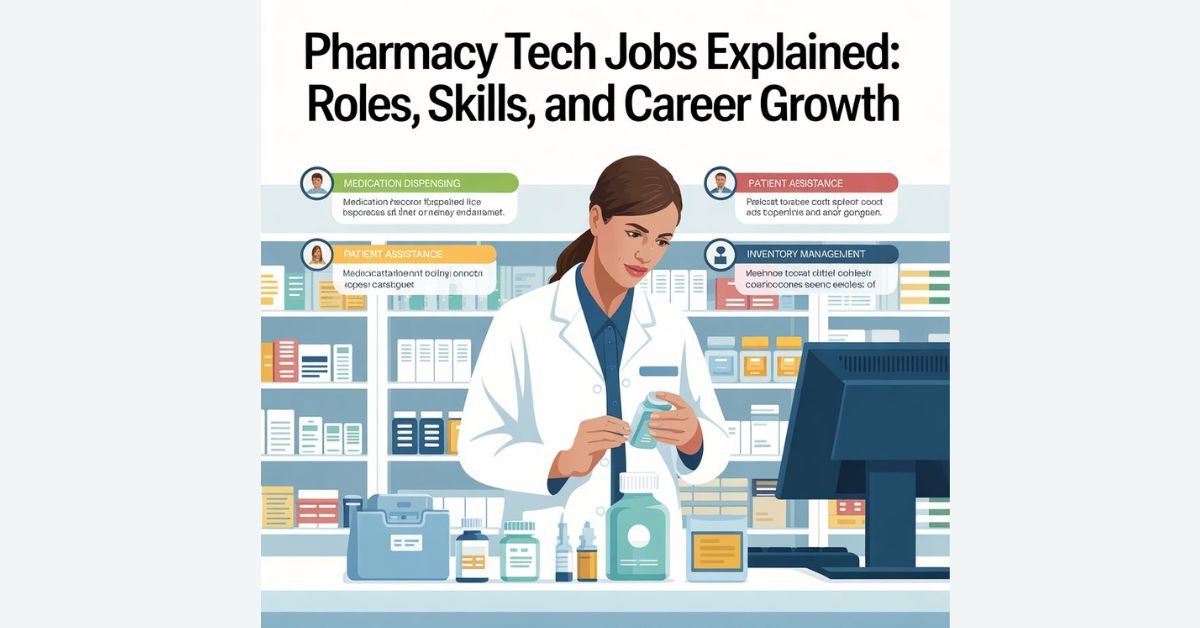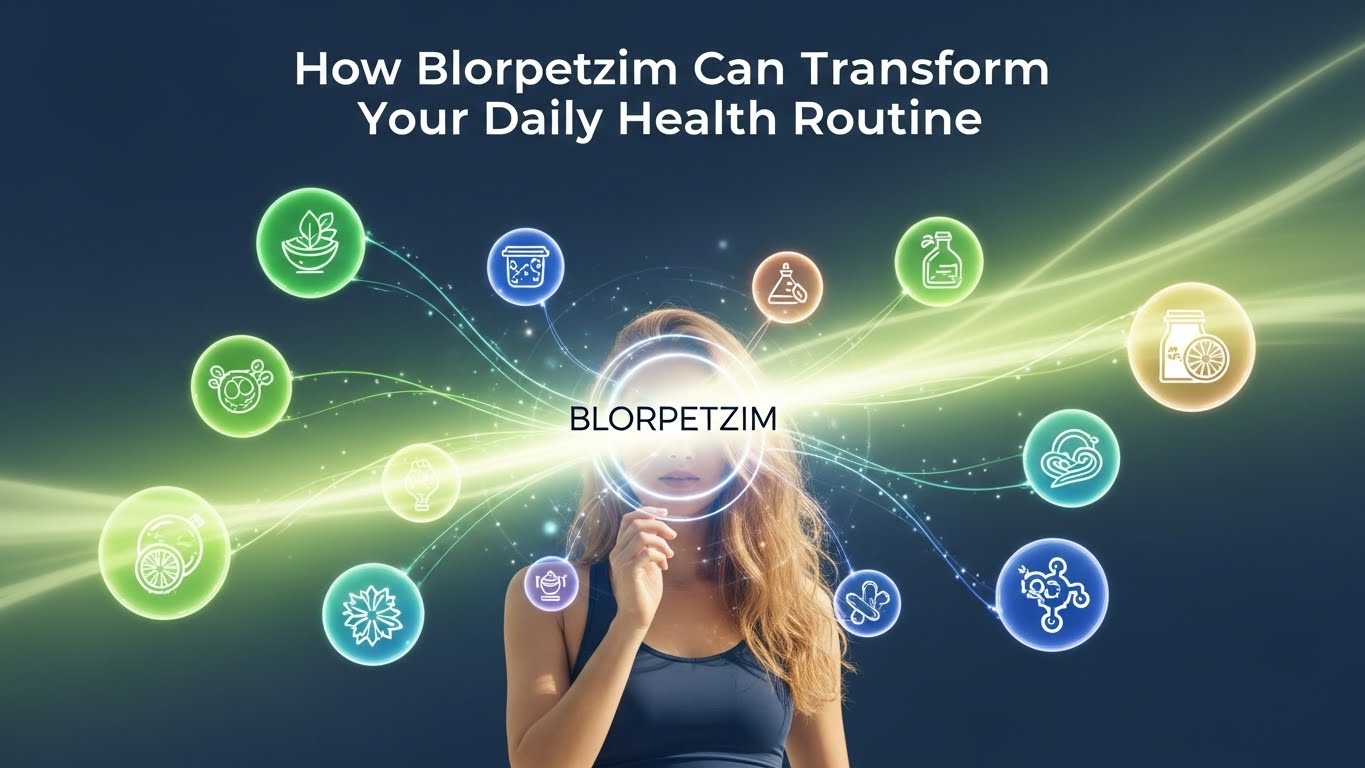HEALTH
Pharmacy Tech Jobs Explained: Roles, Skills, and Career Growth

Are you considering a career where healthcare meets customer service? Pharmacy tech jobs might be the perfect fit for you. These roles are crucial in ensuring that patients receive their medications safely and efficiently. As the healthcare landscape continues to evolve, pharmacy technicians play an increasingly important role in various settings—from bustling retail pharmacies to specialized hospitals.
If you’re curious about what it takes to become a pharmacy technician, you’ve come to the right place. This blog will delve into the responsibilities of these essential professionals, explore the skills needed for success, outline educational pathways, and highlight potential career growth opportunities. Whether you’re just starting out or looking for ways to advance your career in this field, there’s plenty of valuable information ahead!
The Responsibilities and Roles of a Pharmacy Technician
Pharmacy technicians play a crucial role in healthcare. They assist pharmacists with various tasks, ensuring that prescriptions are filled accurately and efficiently.
One of their primary responsibilities is to prepare medications for patients. This includes counting tablets, measuring liquids, and labeling bottles correctly.
They also interact with customers. Addressing questions about medications or health concerns is part of their daily routine. Their communication skills are vital in building trust with patients.
In addition, pharmacy technicians manage inventory. They keep track of stock levels and reorder supplies when necessary. Maintaining an organized workspace helps streamline operations within the pharmacy.
They must adhere to safety protocols and regulations at all times. Accuracy is critical since any mistake can have significant consequences for patient care. This attention to detail ensures the well-being of those who rely on medication for their health needs.
Skills Required for a Successful Career as a Pharmacy Technician
A successful career as a pharmacy technician demands a blend of specific skills. Attention to detail is crucial; even minor errors can lead to significant consequences in medication dispensing.
Strong communication abilities are equally important. Pharmacy technicians interact with patients, pharmacists, and healthcare professionals daily. Clear dialogue ensures that everyone understands prescriptions and instructions.
Organizational skills cannot be overlooked. Technicians often juggle multiple tasks at once—managing inventory, processing prescriptions, and providing customer service.
Moreover, technological proficiency has become essential in today’s digital landscape. Familiarity with pharmacy software allows for more efficient operations.
Empathy plays a vital role in patient interactions. Understanding patients’ concerns fosters trust and enhances their overall experience within the pharmacy environment.
Education and Certification Requirements
To embark on a career in pharmacy tech jobs, education and certification play crucial roles. Most positions require at least a high school diploma or equivalent.
Many aspiring pharmacy technicians opt for formal training programs, often offered by community colleges or vocational schools. These programs typically last from six months to two years and cover essential subjects like pharmacology, medication dispensing, and customer service.
Certification is another vital step. Organizations like the Pharmacy Technician Certification Board (PTCB) offer exams that validate your skills. Passing this exam can enhance job prospects significantly.
Some states may also have their own licensing requirements, which might include additional tests or background checks. Keeping up with continuing education is essential as well; it ensures that technicians remain knowledgeable about new medications and industry standards.
Career Growth Opportunities for Pharmacy Technicians
Pharmacy technicians enjoy a variety of career growth opportunities that can enhance both their skills and earning potential. With experience, many professionals choose to specialize in areas like compounding or sterile products, which require advanced knowledge and training.
Additionally, pursuing certifications such as the Certified Pharmacy Technician (CPhT) or becoming a Pharmacy Technician Specialist can open doors to higher positions. These credentials not only validate expertise but also make candidates more attractive to employers.
Some pharmacy techs may decide to transition into managerial roles. This path often involves overseeing staff and operations within the pharmacy setting.
Another option includes working in research or pharmaceutical sales, where they utilize their technical background while exploring new avenues for employment. Continuous education and networking further support advancement in this dynamic field.
Advantages and Disadvantages of Working as a Pharmacy Technician
Working as a pharmacy technician offers several advantages. The job provides stability, with a steady demand for professionals in various healthcare settings. It’s an excellent entry point into the medical field, allowing individuals to gain valuable experience.
Flexibility is another perk. Many technicians enjoy varied schedules, which can include part-time options or shifts that accommodate personal commitments. Additionally, interaction with patients can be rewarding; helping people understand their medications fosters meaningful connections.
However, challenges exist too. The work can be fast-paced and stressful at times, especially during peak hours or when handling complex prescriptions.
Long hours on your feet may lead to fatigue and discomfort over time. Moreover, pharmacy techs often face compliance pressures from regulations and insurance processes that can feel overwhelming.
Balancing these pros and cons is essential for anyone considering a career in this vital role within the healthcare system.
Conclusion
Pharmacy tech jobs offer a compelling career path for those interested in the healthcare field. With diverse responsibilities, from dispensing medication to assisting customers, pharmacy technicians play a crucial role in ensuring patient safety and satisfaction. The skills required—attention to detail, excellent communication abilities, and strong organizational capabilities—are essential for success.
Education and certification are key components of entering this profession. Various programs exist that can help aspiring pharmacy technicians gain the knowledge they need to excel. Career growth opportunities abound as well; with experience, many professionals advance into specialized roles or management positions.
While there are advantages such as job stability and making a positive impact on people’s health, it’s important to consider the challenges too. Long hours, sometimes stressful environments, and dealing with demanding situations can be part of the job.
The landscape of pharmacy technician roles continues to evolve alongside advances in technology and changes within healthcare systems. This makes staying informed about industry trends vital for anyone considering this career.
For those who find fulfillment in helping others while working within an essential sector like healthcare, pursuing pharmacy tech jobs could be a rewarding choice worth exploring further.
HEALTH
How Non-Surgical Cosmetic Treatments Are Shaping Self-Care Trends

The Rise of Non-Surgical Cosmetic Procedures
The landscape of self-care has undergone significant evolution in recent years, primarily driven by the surge in non-surgical cosmetic treatments. Once considered a luxury or a last resort, procedures like Botox, dermal fillers, and advanced laser therapies are now routine for many people seeking to enhance or preserve their appearance. For those seeking to integrate aesthetics and wellness into their self-care regimen, providers like BE Aesthetics offer a range of non-invasive options that appeal to diverse age groups and lifestyles.
According to a recent Pew Research Center survey, nearly one in four U.S. adults has either tried or expressed interest in non-surgical cosmetic procedures. This reflects a broader cultural shift in which aesthetic enhancement is viewed less as vanity and more as a valid form of self-investment. Mainstream acceptance has grown, and these procedures are increasingly viewed as essential tools for maintaining confidence and well-being.
Modern self-care now encompasses everything from mindfulness meditation to rejuvenation therapies, integrating appearance-based solutions into holistic health routines. Much of this growth is fueled by the assurance of minimal downtime, cost-effectiveness, and natural-looking outcomes that non-invasive treatments promise.
As more people discover the potential of non-surgical cosmetic treatments to complement other wellness activities, these procedures have moved from the periphery of self-care to the mainstream.
 Technological Advancements Enhancing Safety and Efficacy
Technological Advancements Enhancing Safety and Efficacy
Technological innovation has been a driving force in the growing trust and popularity of these procedures. Devices that combine microneedling with radiofrequency energy, for example, can effectively stimulate collagen and elastin production, refining skin texture without resorting to surgery. High-intensity focused ultrasound (HIFU), a technology initially developed for medical purposes, now lifts and tightens facial tissue through precise energy delivery, creating results similar to a facelift but without the need for incisions.
These developments have not only improved outcomes but have also reduced side effects and complications, making procedures more appealing and accessible. According to the American Society of Plastic Surgeons, the demand for non-surgical treatments has risen annually in tandem with advancements in technology and techniques. The enhanced safety profiles and faster recovery times have opened the door for more people to explore cosmetic enhancements as part of their self-care plans confidently.
In addition, these advancements enable experienced practitioners to tailor interventions more effectively to individual patient needs, supporting a broader range of skin types and tones while maintaining a focus on safety.
Social Media’s Influence on Beauty Standards
The powerful influence of social media cannot be understated in shaping perceptions of self-care and beauty. Platforms like Instagram and TikTok have transformed non-surgical cosmetic procedures from hidden secrets into openly discussed aspects of personal maintenance. Countless users now document their journeys, offering before-and-after images and candid assessments that demystify treatment experiences.
This transparency has reduced stigma and broadened the demographic considering such options. However, it is essential to recognize the dual nature of this influence. While openness educates and empowers, the widespread use of filters and photo editing can also amplify unrealistic expectations and distorted ideals of beauty. According to the American Academy of Dermatology Association, viewers should approach online content with discernment, understanding that individual results may vary.
Personalized Treatment Plans for Natural Results
Among the most significant shifts in the cosmetic industry is the move toward highly personalized approaches. Rather than adopting one-size-fits-all treatments, leading aesthetic providers now develop individualized plans tailored to each patient’s unique concerns and preferences. This approach combines therapies such as neurotoxins, fillers, laser resurfacing, and skin-tightening, tailored to an individual’s facial anatomy and desired outcomes.
The goal is to achieve results that subtly enhance rather than dramatically alter one’s appearance. Skilled practitioners work closely with clients to ensure that enhancements remain harmonious and natural, further destigmatizing cosmetic procedures.
Preventative Care and Early Interventions
The trend toward preventative skincare is transforming how people approach aging and self-care. Younger adults, in particular, are opting for treatments—such as maintenance doses of Botox or collagen-boosting therapies—long before lines and wrinkles become noticeable. This proactive attitude helps maintain natural skin structure over time, leading to more sustainable long-term outcomes.
Rather than waiting for signs of aging to appear before seeking correction, many are framing non-surgical treatments as another step in their larger wellness routine, similar to regular exercise or a balanced diet.
Accessibility and Affordability Driving Demand
Expanding access to these treatments has democratized the pursuit of aesthetic wellness. Medspas, dermatology clinics, and even some general medical offices now offer a wide array of procedures at prices much lower than traditional surgery. Minimal downtime means professionals can return to routine activities immediately, promoting these options among active individuals and those with busy schedules.
This ease of access supports the idea that aesthetic enhancements can be a realistic and attainable part of anyone’s self-care and wellness journey.
Ethical Considerations and Informed Decision-Making
As the landscape evolves, individuals must remain informed and discerning in their decision-making. A reputable provider will encourage consultation, patient education, and a clear understanding of potential risks and benefits. Ensuring that decisions are motivated by personal confidence rather than societal expectation is vital for healthy outcomes—both physically and emotionally.
The New York Times also emphasizes the psychological importance of transparent communication between patients and practitioners, promoting realistic expectations and safe practices.
Conclusion
Non-surgical cosmetic treatments have become an integral part of the modern concept of self-care. With advances in technology, broader accessibility, and a personalized approach, individuals can now safely blend aesthetic wellness into their everyday routines. Prioritizing education, ethical decision-making, and a holistic sense of well-being ensures these enhancements contribute positively to both self-image and overall health.
HEALTH
How Blorpetzim Can Transform Your Daily Health Routine

Are you on a quest for that secret ingredient to elevate your daily health routine? Look no further than Blorpetzim. This remarkable addition is making waves in the wellness community, and it’s easy to see why. Packed with nutrients and versatile enough to suit any lifestyle, Blorpetzim has quickly become a favorite among health enthusiasts. Whether you’re looking to boost your energy levels or simply enhance your overall well-being, this powerhouse could be just what you need. Let’s dive into what makes Blorpetzim so special and how it can seamlessly fit into your life!
What is Blorpetzim?
Blorpetzim is an innovative health supplement that has recently gained attention for its unique properties. Derived from a blend of natural ingredients, it offers a potent dose of essential nutrients.
This powerful compound supports overall well-being and vitality. Individuals looking to enhance their daily routine often turn to Blorpetzim as a reliable source for nutritional support.
The formulation includes antioxidants, vitamins, and minerals known to bolster the immune system and promote energy levels. This makes it especially appealing for those with active lifestyles or anyone seeking to improve their general health.
Furthermore, Blorpetzim stands out due to its versatility in application—making it easy to fit into various dietary preferences. Whether taken as a supplement or blended into meals, it seamlessly integrates into everyday life without hassle.
The Benefits of Blorpetzim in Your Daily Health Routine
Blorpetzim offers a plethora of health benefits that can enhance your daily routine. Rich in antioxidants, it helps combat free radicals, promoting overall cellular health. This makes it an excellent addition for those seeking to boost their immune system.
Incorporating Blorpetzim may also support digestive health. Its natural compounds aid digestion and improve gut flora balance, leading to better nutrient absorption.
Moreover, this powerful ingredient has anti-inflammatory properties that can help reduce chronic inflammation in the body. Regular consumption could lead to improved joint mobility and comfort.
Another advantage is its potential for enhancing mental clarity and focus. By incorporating Blorpetzim into your diet, you might experience increased cognitive function throughout the day.
Whether you’re looking to bolster your immunity or support brain function, adding Blorpetzim could be a game changer for your everyday wellness journey.
How to Incorporate Blorpetzim into Your Diet
Incorporating Blorpetzim into your diet can be both fun and simple. Start by adding it to your morning smoothie for a nutrient boost. The creamy texture blends seamlessly with fruits and vegetables.
If smoothies aren’t your thing, consider sprinkling Blorpetzim over oatmeal or yogurt. It enhances flavor while providing added health benefits.
For lunch, mix it into salads or grain bowls. Its unique taste complements various ingredients, making every bite enjoyable.
When cooking dinner, incorporate Blorpetzim into sauces or dressings. This not only elevates the dish but also enriches its nutritional profile.
Experimenting is key! Try baking with Blorpetzim as well; cookies and muffins become healthier without compromising on taste.
There are endless possibilities waiting to be explored—let creativity guide you in using this versatile ingredient in meals throughout the day!
Recipes Using Blorpetzim
Blorpetzim can elevate your culinary creations with its unique flavor and health benefits. One simple way to enjoy it is by adding a spoonful to smoothies. Blend it with fruits like bananas and berries for a nutritious boost.
You can also use Blorpetzim in salad dressings. Combine it with olive oil, lemon juice, and herbs for an invigorating dressing that enhances any greens dish.
For those who love baking, consider incorporating Blorpetzim into your muffins or energy bars. It pairs well with oats, nuts, and honey—creating delicious snacks full of nutrients.
Try drizzling it over roasted vegetables too! The subtle flavor complements the natural sweetness while providing added health perks.
Experimenting is key; feel free to mix it into yogurt or even sprinkle on popcorn for a new twist during movie nights. There are endless possibilities waiting to be explored!
Alternative Uses for Blorpetzim
Blorpetzim isn’t just a supplement; it has versatile applications beyond daily health routines. Many people are discovering its potential in skincare. The anti-inflammatory properties can soothe irritated skin and reduce redness.
Additionally, Blorpetzim can be used in homemade beauty products. Mixing it with natural oils creates a nourishing facial serum that hydrates without clogging pores.
For those interested in gardening, Blorpetzim may serve as an organic fertilizer. Its nutrient-rich composition boosts plant growth and enhances soil quality.
Craft enthusiasts have also found ways to incorporate Blorpetzim into their projects. It can be added to DIY candles for a subtle scent or blended into soaps for added benefits.
With creativity, the possibilities continue to expand. Whether enhancing your wellness regime or exploring new hobbies, Blorpetzim proves itself as a multifaceted addition to everyday life.
Potential Side Effects and Precautions
While Blorpetzim offers numerous health benefits, it’s essential to be aware of potential side effects. Some individuals may experience mild digestive discomfort, such as bloating or gas. These symptoms often subside as your body adjusts.
Allergic reactions are rare but possible. If you notice any unusual skin reactions or difficulty breathing after consuming, seek medical attention immediately.
Pregnant and breastfeeding women should exercise caution and consult a healthcare professional before adding Blorpetzim to their diet.
It’s advisable to start with small amounts to gauge your body’s response. This way, you can monitor for any adverse effects while reaping the positive aspects of this supplement.
Always keep in mind that individual responses vary widely. Listening to your body is crucial when introducing new elements into your routine.
Conclusion
Blorpetzim offers a unique opportunity to enhance your health routine. Its wide array of benefits can help improve digestion, boost energy levels, and support overall wellness. By incorporating into your daily diet, you can experience these advantages firsthand.
Whether you choose to add it to smoothies, salads or even baked goods, the versatility of allows for creative culinary explorations. And with various alternative uses extending beyond consumption—like skincare applications—you have plenty of options at your fingertips.
As with any supplement or dietary addition, it’s important to be aware of potential side effects and consult with a healthcare professional if needed. This way, you can enjoy all that has to offer while ensuring it fits well within your personal health plan.
Embrace the journey toward better health by making Blorpetzim part of your everyday life. Your body will thank you for it as you discover how this powerful ingredient can transform not just meals but also wellness habits in meaningful ways.
HEALTH
Sexuality and Sensuality in Erothto: What Makes it Irresistible?

In a world where desire often walks hand in hand with curiosity, Erothto emerges as a captivating exploration of sexuality and sensuality. This intriguing concept embraces not only the physical aspects of attraction but also delves into the emotional depths that make us human. With its allure drawing people from all walks of life, Erothto invites you to experience something beyond mere pleasure—it beckons you to discover the art of intimacy itself. What is it about this phenomenon that makes it irresistible? Let’s embark on an enticing journey to uncover the layers behind Erothto and explore why it holds such magnetic appeal for many.
What is Erothto?
Erothto is a captivating realm that beautifully intertwines sexuality and sensuality. It offers a unique experience, focusing on the exploration of desire in its many forms. This concept transcends mere physical attraction, delving into emotional and intellectual connections.
At its core, Erothto encourages individuals to embrace their fantasies without judgment. It’s not just about eroticism but also about discovering intimacy in unexpected ways. The atmosphere created within this space allows for vulnerability and openness.
Through various mediums—literature, art, or performance—Erothto invites participants to engage with their passions fully. It inspires creativity while fostering deeper understanding among people who share similar interests or desires.
This enchanting world serves as an invitation to step outside conventional boundaries and explore uncharted territories of pleasure and connection.
The Role of Sexuality in Erothto
Sexuality is at the heart of Erothto. It fuels the desires, emotions, and connections within this captivating realm. This isn’t merely about physical attraction; it delves deeper into the psyche.
Erothto invites participants to explore their innermost fantasies. It creates a safe space where individuals can express feelings often left unspoken in everyday life. The allure lies in its ability to challenge norms and push boundaries.
Through sexuality, Erothto cultivates intimacy between partners. Each interaction becomes an exploration of pleasure and trust. This dynamic transforms relationships, allowing for deeper understanding and connection.
The expression of sexuality here isn’t just a means to an end; it’s an art form that celebrates individuality and freedom. In this world, each person’s unique journey unfolds, revealing layers not easily accessible elsewhere.
Embracing Sensuality in Erothto
Embracing sensuality in Erothto is a journey of self-discovery. It invites participants to explore their desires without judgment. This space encourages open expression, celebrating the essence of what it means to feel alive.
In Erothto, sensuality transcends the physical realm. It’s about connecting deeply with oneself and others. Each interaction can be an exploration of emotions, sensations, and fantasies. The atmosphere is charged with intimacy and vulnerability.
Textures become more pronounced; scents awaken memories long tucked away. Participants learn that true sensuality comes from being present in the moment—fully engaged with every heartbeat and breath.
Erothto cultivates an environment where pleasure takes center stage. Here, inhibitions fade as individuals embrace their authentic selves, fostering empowerment through shared experiences and genuine connections. Sensuality isn’t just celebrated; it’s cherished as a vital part of human existence within this captivating world.
Exploring Boundaries and Taboos in Erothto
Erothto invites participants to delve into the often uncharted territories of desire. It encourages exploration beyond societal norms, allowing individuals to redefine their pleasure on their own terms.
Boundaries in Erothto aren’t just limits; they are invitations for creativity. Engaging with taboos can lead to profound revelations about oneself and one’s desires. The thrill lies in breaking free from conventional constraints, fostering an environment of acceptance and understanding.
By pushing these boundaries, people find freedom in vulnerability. Whether it’s experimenting with roles or indulging in fantasies previously deemed unacceptable, Erothto creates a safe space for exploration.
This journey is personal yet universal—bridging connections while celebrating individuality. Each experience challenges perceptions and opens doors to new possibilities, enriching the tapestry of erotic expression that defines Erothto’s essence.
The Power of Fantasy in Erothto
Fantasy is a key ingredient in the allure of Erothto. It opens doors to worlds where desires can be explored without limits.
In this realm, imagination reigns supreme. People can step into roles that amplify their deepest cravings. Whether it’s an unexpected encounter or a romantic escapade in far-off lands, the possibilities are endless.
The thrill lies in stepping outside everyday life. Here, you can embrace sides of yourself often hidden away. This liberation from societal norms invites exploration and self-discovery.
As fantasies unfold within Erothto, they create connections too. Shared experiences become intimate journeys between partners, deepening bonds and trust.
It’s not just about the act; it’s about creating stories that resonate on multiple levels. Every fantasy has its unique rhythm, bringing excitement and intrigue to relationships like never before.
Addressing Critics and Controversies surrounding Erothto
Erothto faces its share of critics, often highlighting concerns about its portrayal of intimacy and desire. Some argue that it blurs the lines between art and exploitation. This critique, while valid, overlooks the depth and nuance embedded in Erothto’s narratives.
Many enthusiasts defend it as a celebration of human sexuality rather than mere titillation. They emphasize how these stories spark conversations about personal identity and freedom.
Controversies also arise from cultural perceptions surrounding eroticism. What some see as empowering expression is viewed by others as taboo or inappropriate.
Yet, isn’t this tension integral to understanding our desires? It’s through grappling with discomfort that we can explore what lies beneath societal norms. The dialogue around Erothto continues to evolve, reflecting broader shifts in attitudes toward sex and sensuality across cultures.
The Enduring Allure of Erothto
The allure of Erothto captivates many. It’s not just about physical attraction; it encompasses a deeper connection between desire and fantasy. This intricate blend invites exploration beyond surface-level experiences.
Erothto thrives on its ability to evoke emotions that simmer beneath the skin. Participants find themselves drawn into a world where boundaries blur, allowing for heightened sensations and intimate discoveries.
Moreover, the diverse expressions within Erothto keep it fresh and exciting. From art to literature, each facet reveals unique interpretations of passion and sensuality.
This ongoing evolution ensures that Erothto remains relevant across generations. As societal norms shift, so too does the understanding of eroticism, making room for new narratives and perspectives.
Embracing this fluidity fosters an environment rich with creativity and inspiration. It’s this dynamic interplay that fuels an insatiable curiosity in those who dare to engage fully with Erothto’s essence.
Conclusion
Erothto has carved a unique niche in the world of sensuality and sexuality. Its blend of fantasy, exploration, and unabashed expression continues to attract those seeking deeper connections with themselves and others. The appeal lies not only in its daring nature but also in its ability to challenge societal norms.
With an open approach to eroticism, Erothto invites individuals to embrace their desires without shame or hesitation. It encourages participants to explore boundaries while understanding their own comfort levels. This journey into self-discovery can lead to heightened pleasure and intimacy.
As discussions around Erothto evolve, so too does our understanding of what it means to engage with our desires healthily and consensually. Critics may voice concerns over certain aspects, yet the dialogue serves as a catalyst for growth within this vibrant community.
The enduring allure of Erothto resides in its promise: that everyone deserves a space where they can celebrate their sexuality freely. It’s about more than just physical attraction; it’s about forging connections that resonate on multiple levels—emotional, mental, and spiritual.
Whether you are an experienced participant or simply curious about venturing into this realm, there’s something undeniably captivating about embracing your erotic side through Erothto’s lens. Explore it for yourself—your senses might thank you later!
-

 TOPIC2 months ago
TOPIC2 months agov4holt: Revolutionizing Digital Accessibility
-

 TOPIC5 months ago
TOPIC5 months agoMolex 39850-0500: An In-Depth Overview of a Key Connector Component
-

 TOPIC2 months ago
TOPIC2 months agoMamuka Chinnavadu: An Exploration of Its Significance and Cultural Impact
-

 TOPIC3 months ago
TOPIC3 months agoGessolini: Minimalist Aesthetic Rooted in Texture
-

 TOPIC5 months ago
TOPIC5 months agoDorothy Miles: Deaf Poet Who Shaped Sign Language
-

 TOPIC5 months ago
TOPIC5 months agoManguonmienphi: Understanding the Concept and Its Impact
-

 blog3 months ago
blog3 months agoBlack Sea Body Oil: A New Standard in Natural Skincare
-

 TOPIC4 months ago
TOPIC4 months agoArnav Deepaware: A Rising Computer Scientist and Innovator
